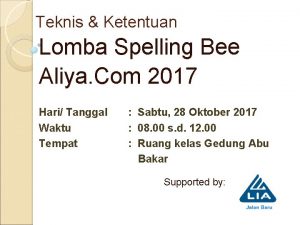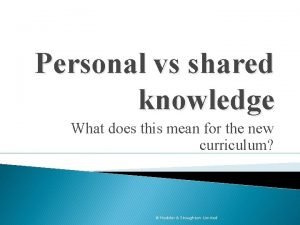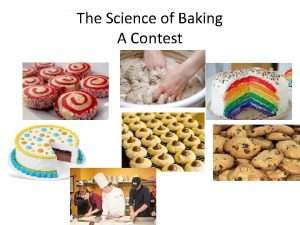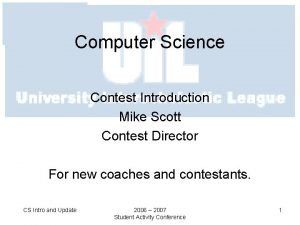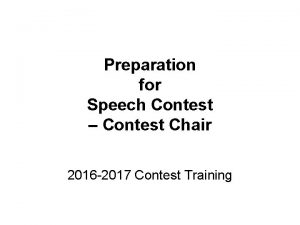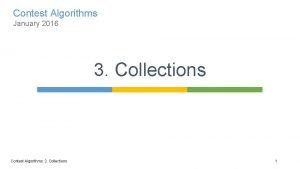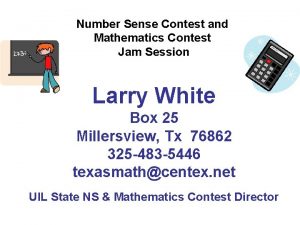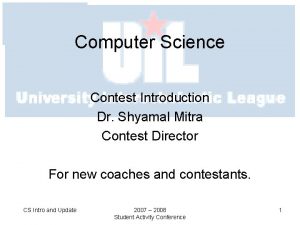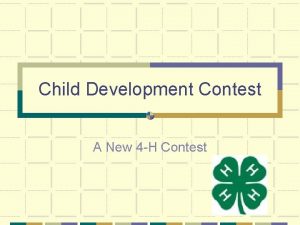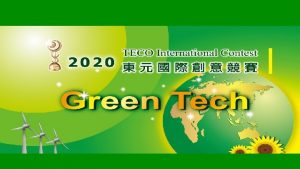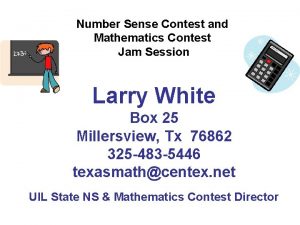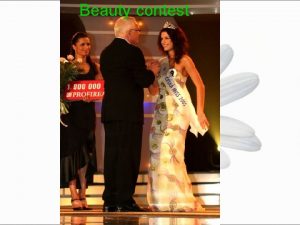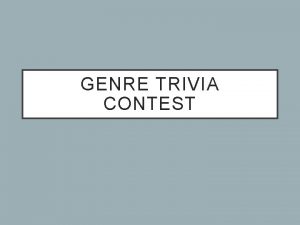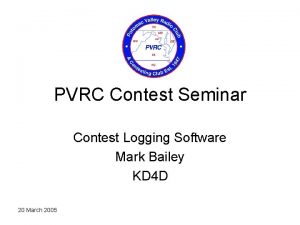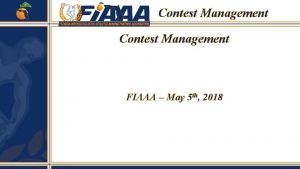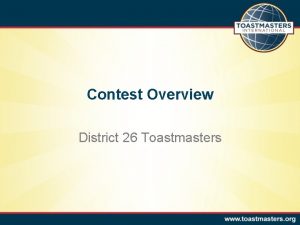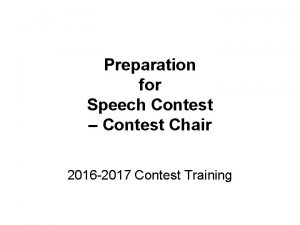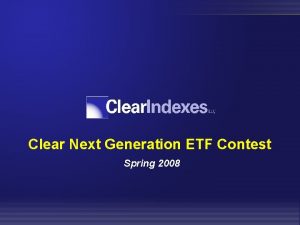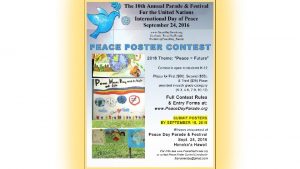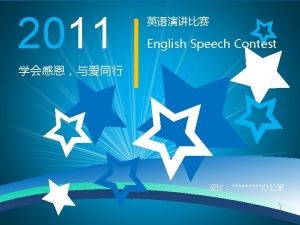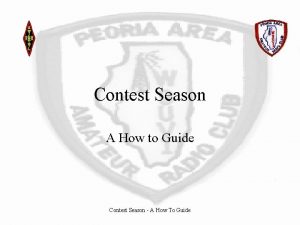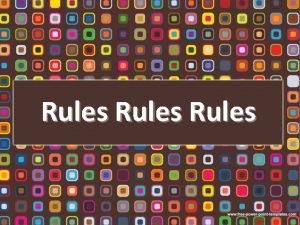Rules for the Knowledge Contest 1 This contest






















































- Slides: 54

Rules for the Knowledge Contest 1. This contest consists of 42 questions (35 knowledge & 5 “fun” questions & 2 bonus questions) © 2005 John Wiley & Sons 2. It is a close-book contest since I think these are the basics you need to know after a Marketing Strategy course. 3. There are required questions (30), competitive questions (10) and remedy questions (2). 1

Required Questions 6 runs in total © 2005 John Wiley & Sons • • 30 knowledge questions are required questions. Each student is required to answer one question. Each question is worth 10 points. If the first answer is wrong, the student could ask his/her group peers for help. • If the second answer is right, the group can still get 5 points. • If no one in the group could answer the question right, the group will be deducted 5 points. 2

© 2005 John Wiley & Sons Competitive Questions 10 questions • 10 competitive questions: 5 - knowledge & 5 - fun • Each question is won by the team who "buzzes in" first and answers the question correctly. • Teams may buzz in at any point after the question is presented in the screen. • If the first answer wrong, the team can purposely select one other group to answer the same question. • Each question to be answered at the first time is worth 20 points • At the second time, the question is worth 10 points. • The group with wrong answer will be punished 20 3 points.

Remedy Questions 2 questions © 2005 John Wiley & Sons 2 remedy questions, one worth 30 points will be given to the weakest team at the moment; wrong answer will not be punished. If the first answer is wrong, the question will be passed to the second weakest team. 4

© 2005 John Wiley & Sons Required Questions 1 st run 5

Question 1*: Fill-in-blank question: © 2005 John Wiley & Sons The four elements of a business strategy for a firm are the product-market investment decision, functional area strategies, the customer value proposition and 6

© 2005 John Wiley & Sons Question 2: MC question: Strategic marketing is involved in making decisions, some of which include investment decisions: (a) Invest for growth (b) Milk (c) Maintain (d) Liquidate (e) Innovation 7

Question 3: Fill-in-blank question: © 2005 John Wiley & Sons Uncertainty can be handled by precipitating a strategic decision, by obtaining information to reduce the uncertainty, and by 8

Question 4*: Fill-in-blank question: © 2005 John Wiley & Sons There are two ways to group competitors; one based on competitor’s strategies and the other is based on 9

© 2005 John Wiley & Sons Question 5: MC question: In conducting a competitor analysis, which of the following is not relevant: (a)Accounting methodologies (b)Market share (c)Image (d)Positioning strategy (e)Objectives and commitments 10

© 2005 John Wiley & Sons Required Questions 2 nd run 11

© 2005 John Wiley & Sons Question 6: MC question: Potential market entrants might use all but one of the following to enter a market: (a)Market expansion (b)Market penetration (c)Product expansion (d)Backward/forward integration (e)Export assets or competencies 12

© 2005 John Wiley & Sons Question 7: MC question: Which of the following is not an indicator of market maturity or decline? (a)Customer disinterest (b)Price pressure (c)Saturation (d)Predictions for high growth (e)Buyer sophistication and knowledge 13

Question 8: True or false question: © 2005 John Wiley & Sons The goals of environmental analysis are to identify fads, trends and events that will only affect strategy in a direct way. 14

Question 9: True or false question: © 2005 John Wiley & Sons In the survey of 248 West Coast business managers, the most frequently mentioned SCA was financial resources. 15

Question 10*: MC question: © 2005 John Wiley & Sons A sustainable competitive advantage has several characteristics. Which of the following is not one of them? (a)Sustainability (b)They can be leveraged (c)They should be supported by assets and competencies (d)They cannot easily be neutralized by competitors (e)They are easily copied 16

© 2005 John Wiley & Sons Required Questions 3 rd run 17

Question 11*: True or false question: © 2005 John Wiley & Sons An SCA is necessary to compete and a KSF is the basis for a continuing advantage. 18

© 2005 John Wiley & Sons Question 12: MC question: Which of the following is not one of the three philosophies of developing strategy? (a)Strategic Drift (b)Strategic Opportunism (c)Strategic Adaptability (d)Strategic Commitment 19

Question 13*: Fill-in-blank question: © 2005 John Wiley & Sons A business strategy should be challenged with respect to whether it contains a real and perceived value proposition and whether that value proposition is relevant, and 20

Question 14: MC question: © 2005 John Wiley & Sons Which of the following is not a competitive advantage included in brand loyalty: a. Reducing marketing costs b. Entry to barrier c. Increased name recall at time of purchase d. Satisfied customer base projects successful product e. Provides time to respond to competitive moves 21

Question 15: Quick recall question: © 2005 John Wiley & Sons What are three steps of creating a brand identity ? 22

© 2005 John Wiley & Sons Required Questions 4 th run 23

Question 16*: Fill-in-blank question: © 2005 John Wiley & Sons The four ways to grow a business are to go global, to energize the business, and to and. 24

© 2005 John Wiley & Sons Question 17: MC question: Brand extension evaluation asks three questions according to the book. Which of the following is not a brand extension question among the three? a. Will the brand extension be profitable? b. Will the extension enhance the brand name and image? c. Does the brand fit the new context? d. Does the brand add value to the offering in the new product class? 25

Question 18*: Fill-in-blank question: © 2005 John Wiley & Sons Effective global brand management involves an organizational entity to create crosscountry synergy, a system to create brandbuilding brilliance, , and. 26

Question 19: Fill-in-blank question: © 2005 John Wiley & Sons Strategic brand consolidation process includes five distinct steps: identifying the relevant brand set, , , Creating a revised brand portfolio strategy and designing a transition strategy 27

Question 20: True or false question: © 2005 John Wiley & Sons Business portfolio analysis provides a structured way to evaluate business units on two key dimensions: - the attractiveness of the market involved - the strengths of competitor’s position in that market. 28

© 2005 John Wiley & Sons Required Questions 5 th run 29

Question 21*: Quick recall question: © 2005 John Wiley & Sons What are the four dimensions of an organization? 30

© 2005 John Wiley & Sons Question 22: MC question: An organization’s culture involves all but one of the following: a. Symbolic actions b. Shared values c. Norms of behavior d. Managerial style of the CEO e. Symbols 31

Question 23: Fill-in-blank question: , © 2005 John Wiley & Sons The hit industry topology includes , and. 32

Question 24: True or false question: © 2005 John Wiley & Sons A strategic group is a customer segment that is strategically important to the business. 33

© 2005 John Wiley & Sons Question 25: MC question: Exit barriers are crucial to a firm’s ability to exercise an exit alternative. Which of the following is not an exit barrier? a) Managerial pride b) Government or social barriers c) Specialized assets d) High market growth rate e) Fixed costs 34

© 2005 John Wiley & Sons Required Questions 6 th run 35

Question 26: True or false question: © 2005 John Wiley & Sons A user gap is caused when one segment uses more of a product than another segment. 36

Question 27*: Fill-in-blank question: © 2005 John Wiley & Sons Porter’s five factor model involves – the intensity of competition, competition among existing firms, , , and. 37

© 2005 John Wiley & Sons Question 28: MC question: Which of the following is not a risk of a high growth market? a) Overcrowding b) Superior competitive entry c) Projected high growth d) Changing KSFs e) Resource constraints 38

Question 29: Fill-in-blank question: , © 2005 John Wiley & Sons The three components of environmental analysis are , and. 39

Question 30: Fill-in-blank question: © 2005 John Wiley & Sons Two benefits a strategic alliance can get are that it can help a firm overcome trade barriers and that it can. 40

© 2005 John Wiley & Sons Competitive Questions 10 questions • 10 competitive questions: 5 - knowledge & 5 - fun • Each question is won by the team who "buzzes in" first and answers the question correctly. • Teams may buzz in at any point after the question is presented in the screen. • If the first answer wrong, the team can purposely select one other group to answer the same question. • Each question to be answered at the first time is worth 20 points • At the second time, the question is worth 10 points. • The group with wrong answer will be punished 20 41 points.

Question 31*: Fill-in-blank question: © 2005 John Wiley & Sons Strategy decisions should be based on three types of assessment: organizational strengths and weaknesses; competitor strengths, weaknesses and strategies; and 42

Question 32: True or false question: © 2005 John Wiley & Sons The goal of strategic management is to develop a strategy that exploits business strengths and competitor weakness and neutralizes business weaknesses and competitor strengths. 43

Question 33: Fill-in-blank question: © 2005 John Wiley & Sons Innovation can create what is often termed as. 44

Question 34: True or false question: © 2005 John Wiley & Sons Blue ocean business and red ocean business both generally allow for above average earnings. 45

Question 35*: Fill-in-blank question: The brand identity elements should be: © 2005 John Wiley & Sons Resonate with the market; Differentiate or reflect points of parity; Have or Gain Credibility and. 46

Question 36: © 2005 John Wiley & Sons Apple Daily was launched in the newspaper market in 1995 with indirect promotional strategies to reduce its cover price to Such price cutting caused confusion and uncertainty in the newspaper market in Hong Kong where the selling price was standardized at. 47

Question 37: The core competencies of Apple Daily are. © 2005 John Wiley & Sons and 48

Question 38: © 2005 John Wiley & Sons Medicine East’s Franchise Package The franchise fees include as initial fees. After that, the franchisee has to pay royalty on its monthly sales revenue. The franchisee has to secure his or her own store outlet and pay for its renovation. 49

Question 39: © 2005 John Wiley & Sons Recall at least two Youtube clips (brand names or company names) we have watched in the class for this course. 50

Question 40: © 2005 John Wiley & Sons There were two students who used Power. Point for their mid-term essay presentation. Who are they? 51

Remedy Questions 2 questions © 2005 John Wiley & Sons 2 remedy questions, one worth 30 points will be given to the weakest team at the moment; wrong answer will not be punished. If the first answer is wrong, the question will be passed to the second weakest team. 52

Question 41: Remedy question © 2005 John Wiley & Sons What are the exact time and venue for the final exam of MKT 355? 53

Question 42: Remedy question: © 2005 John Wiley & Sons Would you recall the five companies on which our five groups choose to focus in their term projects? 54
 Teknis lomba spelling bee
Teknis lomba spelling bee Naming contest rules
Naming contest rules What is shared knowledge
What is shared knowledge Knowledge shared is knowledge squared
Knowledge shared is knowledge squared Knowledge shared is knowledge multiplied meaning
Knowledge shared is knowledge multiplied meaning Knowledge creation and knowledge architecture
Knowledge creation and knowledge architecture Contoh shallow knowledge dan deep knowledge
Contoh shallow knowledge dan deep knowledge Posteriori knowledge definition
Posteriori knowledge definition Book smarts definition
Book smarts definition Shared knowledge vs personal knowledge
Shared knowledge vs personal knowledge Gertler econ
Gertler econ Kontinuitetshantering i praktiken
Kontinuitetshantering i praktiken Typiska novell drag
Typiska novell drag Tack för att ni lyssnade bild
Tack för att ni lyssnade bild Ekologiskt fotavtryck
Ekologiskt fotavtryck Varför kallas perioden 1918-1939 för mellankrigstiden
Varför kallas perioden 1918-1939 för mellankrigstiden En lathund för arbete med kontinuitetshantering
En lathund för arbete med kontinuitetshantering Särskild löneskatt för pensionskostnader
Särskild löneskatt för pensionskostnader Personlig tidbok
Personlig tidbok Sura för anatom
Sura för anatom Förklara densitet för barn
Förklara densitet för barn Datorkunskap för nybörjare
Datorkunskap för nybörjare Boverket ka
Boverket ka Mall debattartikel
Mall debattartikel För och nackdelar med firo
För och nackdelar med firo Nyckelkompetenser för livslångt lärande
Nyckelkompetenser för livslångt lärande Påbyggnader för flakfordon
Påbyggnader för flakfordon Formel för lufttryck
Formel för lufttryck Offentlig förvaltning
Offentlig förvaltning Kyssande vind analys
Kyssande vind analys Presentera för publik crossboss
Presentera för publik crossboss Jiddisch
Jiddisch Vem räknas som jude
Vem räknas som jude Treserva lathund
Treserva lathund Epiteltyper
Epiteltyper Bästa kameran för astrofoto
Bästa kameran för astrofoto Centrum för kunskap och säkerhet
Centrum för kunskap och säkerhet Lågenergihus nyproduktion
Lågenergihus nyproduktion Mat för unga idrottare
Mat för unga idrottare Verktyg för automatisering av utbetalningar
Verktyg för automatisering av utbetalningar Rutin för avvikelsehantering
Rutin för avvikelsehantering Smärtskolan kunskap för livet
Smärtskolan kunskap för livet Ministerstyre för och nackdelar
Ministerstyre för och nackdelar Tack för att ni har lyssnat
Tack för att ni har lyssnat Vad är referatmarkeringar
Vad är referatmarkeringar Redogör för vad psykologi är
Redogör för vad psykologi är Stål för stötfångarsystem
Stål för stötfångarsystem Tack för att ni har lyssnat
Tack för att ni har lyssnat Borra hål för knoppar
Borra hål för knoppar Orubbliga rättigheter
Orubbliga rättigheter Formel gruplar
Formel gruplar Tack för att ni har lyssnat
Tack för att ni har lyssnat Steg för steg rita
Steg för steg rita Vad är verksamhetsanalys
Vad är verksamhetsanalys Tobinskatten för och nackdelar
Tobinskatten för och nackdelar
